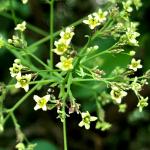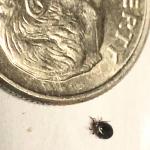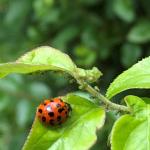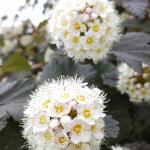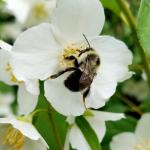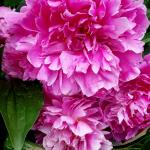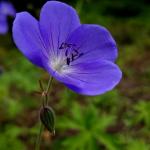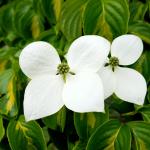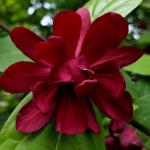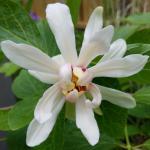UMass Extension's Landscape Message is an educational newsletter intended to inform and guide Massachusetts Green Industry professionals in the management of our collective landscape. Detailed reports from scouts and Extension specialists on growing conditions, pest activity, and cultural practices for the management of woody ornamentals, trees, and turf are regular features. The following issue has been updated to provide timely management information and the latest regional news and environmental data.
To read individual sections of the message, click on the section headings below to expand the content:
Scouting Information by Region
Environmental Data
The following data was collected on or about June 6, 2018. Total accumulated growing degree days (GDD) represent the heating units above a 50° F baseline temperature collected via our instruments for the 2018 calendar year. This information is intended for use as a guide for monitoring the developmental stages of pests in your location and planning management strategies accordingly.
|
MA Region/Location |
GDD |
Soil Temp |
Precipitation |
Time/Date of Readings |
||
|
1-Week Gain |
2018 Total |
Sun |
Shade |
|||
|
Cape Cod |
69 |
354.5 |
64 |
59 |
1.70 |
3:00 PM 6/6 |
|
Southeast |
64 |
374 |
65 |
57 |
0.85 |
4:15 PM 6/6 |
|
North Shore |
95 |
539 |
59 |
54 |
0.53 |
9:00 AM 6/6 |
|
East |
83 |
510 |
63 |
56 |
0.91 |
2:00 PM 6/6 |
|
Metro West |
85 |
526.5 |
57 |
54 |
0.63 |
5:30 AM 6/6 |
|
Central |
85 |
401 |
56 |
50 |
0.62 |
7:00 AM 6/5 |
|
Pioneer Valley |
88 |
512 |
65 |
57 |
1.22 |
11:00 AM 6/6 |
|
Berkshires |
108 |
493 |
60 |
56 |
0.76 |
8:00 AM 6/6 |
|
AVERAGE |
85 |
464 |
61 |
55 |
0.90 |
- |
|
n/a = information not available |
||||||
Drought conditions update: As of June 5, Massachusetts is beginning to show level D0 - 'Abnormally Dry' - in most of Middlesex County, the northwestern two-thirds of Essex County and the northeastern two-thirds of Worcester County. Use this link to see the map:
http://droughtmonitor.unl.edu/CurrentMap/StateDroughtMonitor.aspx?MA
Phenology
| Indicator Plants - Stages of Flowering (BEGIN, BEGIN/FULL, FULL, FULL/END, END) | ||||||||
|---|---|---|---|---|---|---|---|---|
| PLANT NAME (Botanic/ Common) | CAPE | S.E. | N.S. | EAST | METRO W. | CENT. | P.V. | BERK. |
|
Philadelphus spp. (Mockorange) |
Begin/Full |
Full |
Full |
Full |
Full |
Full |
Full |
Begin |
|
Hydrangea anomala petiolaris (Climbing Hydrangea) |
Begin/Full |
Full |
Begin/Full |
Begin |
Full |
Full |
Full |
Begin |
|
Kalmia latifolia (Mountain-laurel) |
* |
* |
Begin |
Begin |
Begin |
Begin |
Full |
* |
|
Cotinus coggygria (Common Smokebush) |
* |
Full |
Begin |
Full |
Begin |
* |
Begin |
Begin |
|
Cornus sericea (Red Osier Dogwood) |
Begin |
* |
Begin |
End |
Full/ End |
Full/ End |
Begin |
* |
|
Chionanthus virginicus (Fringe Tree) |
Full |
Full |
Full |
Full |
Full |
Full |
Full/End |
Full |
|
Cornus kousa (Kousa Dogwood) |
Begin Full |
Full |
Begin |
Begin |
Bgin/Full |
Begin |
Full |
Begin/Full |
|
Robinia pseudoacacia (Black Locust) |
Full |
Full |
Full/End |
End |
Full |
End |
Full/End |
Full |
|
Kolkwitzia amabilis (Beautybush) |
* |
Full |
Full |
Full |
Full |
Full |
Full |
Full |
|
Weigela florida (Old Fashioned Weigela) |
Full |
Full |
Full |
Full |
Full |
Full |
Full |
Full |
|
Deutzia spp. (Deutzia species) |
Full |
Full |
Full/End |
Full |
Full |
Full |
Full |
Full |
|
Enkianthus campanulatus (Redvein Enkianthus) |
Full |
Full/End |
Full |
Full |
Full |
Full |
End |
Full/End |
|
Rhododendron catawbiense (Catawba Rhododendron) |
Full |
Full |
Full/End |
Full/End |
Full |
Full/ End |
Full/End |
Full |
| * = no activity to report/information not available | ||||||||
Regional Notes
Cape Cod Region (Barnstable)
General Conditions: The average temperature over the period was 59°F with a high of 77°F on June 2 and a low of 47°F on June 4. From June 3 thru June 6 temperatures were cooler than average staying primarily in the 50s. Precipitation on June 4 provided 1.7 inches of rain, keeping soil moisture conditions adequate and giving a good watering for all those recently planted vegetable gardens, annual flower beds, etc. Precipitation, high humidity and extended cloudiness have created great conditions for fungal diseases.
Pests/Problems: Winter moth larvae are done feeding and have migrated to the ground to pupate. Some cankerworm (spring or fall) can be found feeding and may be mistaken as winter moth. Gypsy moth can be seen primarily on the outer Cape but the occasional caterpillar(s) can also be found in the upper and mid Cape. Other pests of damage observed this week include: two spotted spidermite on tropical hibiscus, viburnum leaf beetle larvae (Pyrrhalta viburni) feeding on viburnum, rose slug sawfly larvae feeding on rose, boxwood psyllid (Psylla buxi) on boxwood, boxwood leafminer (Monarthropalpus flavus) has pupated and adults (midges) are active, hydrangea leaftier (Olethreutes ferriferana) on smooth hydrangea (H. arborescens), columbine leafminer (Phytomyza aquilegivora) on columbine, slugs on bearded iris, Native holly leafminer (Phytomyza ilicicola) on American holly, brown rot on ‘Kwanzan cherry’, sycamore anthracnose on sycamore, spot anthracnose on dogwood, cedar apple rust on crabapple, turpentine beetle on pitch pine, black spot on rose, exobasidium gall on azalea, Volutella canker on boxwood, peach leaf curl on peach and red thread rampant in turf. The following weeds can be found in bloom: black swallowwort (Cynanchum nigrum), oriental bittersweet (Celastrus orbiculatus), bush honeysuckles (Lonicera spp), mouse-ear chickweed (Cerastium vulgatum), yellow rocket (Barbarea vulgaris), buttercup (Ranunculus spp.), red sorrel (Rumex acetosella), narrowleaf plantain (Plantago lanceolate), black medic (Medicago lupulina) and white clover (Trifolium repens). Rabbits are abundant. Black legged ticks (deer tick) nymphs are active so keep yourself protected with permethrin-treated shoes and clothing.
Southeast Region (Hanson)
General Conditions: The variable and changeable New England spring weather continued this past week with many people referring to it as “June Gloom”. Hot 80’s with humidity on June 1st, 2nd, and 3rd dropped 30 degrees on June 3rd , resulting in only 51 degrees in the late afternoon and an overnight temperature of 48 degrees. June 4th brought a cool temperature of 51 degrees and a fine, drizzly rain all day followed by more cool weather and rain on Tuesday. Hanson and other SE areas needed the rain and everyone was hoping for more. Hanson received 0.85 inches of needed rain. Continue to remind clients to water their plants, especially those newly planted or ones that were defoliated or damaged by last year’s caterpillar feeding.
The following plants are in full bloom: Cornus kousa, Cladrastis kentukea, Aesculus pavia, Laburnum watereri (Goldenchain Tree), Rhododendrons, Robinia hispida, Kerria, Lonicera ‘John Clayton’, Philadelphus spp. (Mockorange), Chionanthus virginicus, Aristolochia durior (Dutchman's pipe), Viburnum opulus, V. plicatum var. tomentosum (Doublefile Viburnum), Beautybush, Stephanandra incisa ‘Crispa’, Abelia mosanensis, Cytisus scoparius (Scotch broom), Syringa x prestoniae ‘James Macfarlane’, Syringa ‘Miss Kim’, Clematis, Rosa ‘Linda Campbell’, Physocarpus opulifolius (Eastern Ninebark), Calycanthus floridus (Carolina allspice), Weigela florida, Peonies, Oriental poppies, Allium, Baptisia australis and Baptisia hybrids, Dianthus spp., Tradescantia, Anemone canadensis, Amsonia spp., Thalictrum aquilegifolium, Geranium spp., Buglossoides purpurocaerulea, Doronicum spp., Tiarella, Lamium, Dicentra spectabilis (Bleeding heart), Cypripedium spp., (Lady’s Slipper), Polygonum bistorta ‘Superbum’, Corydalis lutea, Siberian Iris, bearded iris, Aquilegia spp. (Columbine) and Vinca minor.
Cotinus coggygria (Smokebush) and Cotinus obovatus (American Smoketree) are in full bloom with small greenish flowers (photo 1); the “smoke” will appear after bloom.
The following plants are ending bloom: Syringa meyeri, Cornus controversa, Cornus alternifolia and Rutgers hybrid dogwoods (Stellar series). Pine pollen replaced oak pollen past week, covering everything with yellow dust. The rain helped to clear the air and clean the surfaces of the pollen. Clear weed is growing by leaps and bounds as well as numerous other weeds; it’s a great year for weeds. Continue to remove seedlings of Massachusetts invasive plants like Norway maple, barberry, autumn olive and burning bush before they become established; also prune and/or shear barberry, autumn olive and burning bush to remove flowers and newly set seeds to prevent further seed dispersal.
Pests/Problems: Winter moth caterpillars have pupated, thus ending their feeding for the 2018 season. Overall, foliar damage appears minimal from winter moth caterpillar feeding this year. So many people have commented on how “green and luscious” the landscape looks with all the undamaged leaves of Japanese maples and other trees/shrubs looking great for the first time in years.
Gypsy moth caterpillars are in their 3rd and 4th instar. Observations in Plymouth County and reports from South Dartmouth, Westport and Rehoboth, MA all indicate that while gypsy moth caterpillars are present, especially on oaks, damage appears minimal currently. That could change as the caterpillars increase in size and in those areas where gypsy moths may be present in high numbers. Hopefully, the recent cool, wet weather will be conducive to the caterpillar-killing fungus Entomophaga maimaiga which would help decrease the gypsy moths that are here for the 2018 season. Reports from the Westport and Dartmouth areas included field observations that many oak trees are dead from recent, previous years' gypsy moth caterpillar defoliation, as well as the drought following defoliation.
The small, coppery European chafer beetle is active now, feeding on a wide range of plant material, usually at night. Also active are Asiatic garden beetle and golden tortoise beetle (photo 2). This shiny, gold beetle can often be seen feeding on the foliage of ornamental sweet potato vines causing damage (photo 3).
Four-lined plant bugs are active. Monitor herbaceous perennials for numerous, small, round, brown-black spots coalescing on the foliage, an indication that the damage could be from the feeding of four-lined plant bug nymphs (orange-red with black coloration). Nymphs and adults (gold-green with 4 longitudinal black stripes) have piercing-sucking mouthparts and the resulting damage often resembles a leaf spot disease (photo 4).
The native White-spotted Pine Sawyer may soon be observed in the landscape. This large beetle is one of a number of Asian Longhorned Beetle (ALB) “look-alikes”, but is not an insect that attacks healthy trees like ALB.
https://massnrc.org/pests/albdocs/ALBLookalikes_Massachusetts.pdf
Euonymus caterpillars are active on Euonymus spp. The caterpillars (cream-colored with black spots) can be seen feeding inside the webs on the foliage that they have webbed together. Monitor the undersides of foliage of Pieris, Rhododendron and azaleas for lacebug and manage if found. Cottony Taxus Scale (also known as Cottony Camellia Scale) remains active on Taxus and Meserve hollies. Inspect stems and the undersides of the foliage for the white, cottony egg masses. Orthacheta Bud Fly (Iris bud fly) remains active on Iris sibirica (Siberian iris), Iris pseudacorus and bearded Iris. Monostegia abdominalis remains actively feeding on Lysimachia ciliata ‘Purpurea’.
Reports continue to come in from many people who have pulled off multiple deer ticks; the inference is that it is a bountiful year for deer ticks! Deer ticks are capable of transmitting several diseases. Deer tick nymphs remain active. The ticks at nymphal stage are small like a poppy seed. After feeding, they might be the size of a sesame seed, as can be seen in this photo of a deer tick nymph recently taken off an unsuspecting gardener (photo 5). The deer tick nymph stage is often thought to be most responsible for transmitting Lyme disease. Repellents and frequent tick checks are recommended for everyone working or playing outdoors, especially in grassy areas or areas with leaf litter. See the Insect section of the Landscape Message.
The following insects are active: Lily leaf beetle and larvae, roseslug sawfly, dog ticks, carpenter ants, spruce spider mite, hemlock woolly adelgid, elongate hemlock (Fiorina scale) scale, aphids, woolly beech aphid on beech, slugs, snails, ants, deer flies, wasps, hornets and carpenter bees. Boxwood psyllid should be about finished feeding. If the foliage is cupped and distorted by their feeding, it can be sheared or cut back now to improve the look. Everyone seems to be complaining about the viciousness and frequency of mosquitoes this year! Remind clients to empty containers of water to help prevent breeding and consider using Bti (Bacillus thuringiensis israelensis) in birdbaths, plant saucers, etc. Azalea sawfly appears to be finished feeding for the season. Beneficial insects like hoverflies are active, as well as ladybugs feeding on aphids (photo 6). Swallowtail butterflies continue to flutter by.
Foliar diseases continue to appear: monitor flowering dogwood for dogwood anthracnose and apples and crabapples for apple scab. The irregular-shaped brown splotches caused by the fungus, Phyllosticta hamamelidis (Witchhazel blight), continues to show up and spread on the foliage of ‘Arnold Promise’ witchhazel. Other witchhazels in the vicinity do not seem to be infected. Multiflora rose (invasive), oxeye daisy, buttercups, clover, ground ivy, veronica and chickweed are in full bloom. The weedy vine, bindweed, is showing up and climbing over plants, garden stakes, etc. Pull and remove bindweed now before it matures and goes to seed. Woodchucks are active and eating various garden plants such as Campanula, Phlox, Echinacea and vegetable plants. Raccoons are showing up at bird feeders and deer, squirrels, wild turkeys, voles and chipmunks continue to be active.
North Shore Region (Beverly)
General Conditions: The weather during this reporting period was mostly cloudy and overcast with occasional rain showers. Approximately 0.53 inches of rain was recorded at Long Hill. Temperatures were unseasonably cool for this time of the year, feeling like early spring rather than the unofficial early summer. Day temperatures ranged from the mid 50s to low 60s and night temperatures ranged from the high 40s to low 50s except for June 2nd when 80 degrees was recorded at Beverly. We gained 95 growing degree days during this reporting period. Woody plants seen in bloom include: Fragrant snowbell tree (Styrax obassia), Chinese Neillia (Neillia sinensis), Wisteria (Wisteria floribunda), Tree Wisteria (Wisteria longissima alba), Slender Deutzia (Deutzia gracilis), Fringe tree (Chionanthus virginicus), American cranberrybush Viburnum (Viburnum trilobum), Doublefile Viburnum (Viburnum plicatum var. tomentosum), Constellation Rutgers dogwood (Cornus x rutgersensis), Redvein Enkianthus (Enkianthus campanulatus), Little leaf lilac (Syringa microphylla), Beautybush (Kolkwitzia amabilis), Japanese Wisteria (Wisteria floribunda) and some azalea varieties. Some of the non-woody plants seen in bloom include: Fetterbush (Leucothoe fontanesiana), Scotch rose (Rosa spinosissima), Peony (Paeonia spp.), Cranesbill (Geranium spp.), Bleeding heart (Dicentra spectabilis), Solomon’s seal (Polygonatum odoratum), Blue star (Amsonia hubrichtii), Fleece plant (Persicaria amplexicaulis), Milkweed (Asclepias spp.) and several annuals.
Pests/Problems: Galls of azalea leaf and flower gall (Exobasidium vaccinii) were observed on some azaleas. Cottony Taxus Scale was observed on some yews. Viburnum leaf beetles continue to enlarge and are causing serious damage on American cranberrybush Viburnum. The leaves are almost completely skeletonized. Arrowwood Viburnum is also slightly affected. Other viburnums are not affected. Eastern tent caterpillar webs were also observed on branches of crabapples and cherry trees. They are ballooning and feeding on the leaves. Invasive plant species observed in flower include Autumn olive (Elaeagnus umbellata) and Burning bush (Euonymus alatus). Seedlings of Norway maple (Acer platanoides) were observed sprouting in the landscape. Weeds observed in flower include: Dandelion (Taraxacum officinale), Ground ivy (Glechoma hederacea), Garlic mustard (Alliaria petiolata), Deadnettle (Lamium purpureum), common chickweed (Stellaria media) and Common groundsel (Senecio vulgaris). Mosquitoes and ticks are very active. Protect yourself with a repellent when working outdoors.
East Region (Boston)
General Conditions: We experienced another week of fluctuating spring weather. The week began with temperatures in the 80’s before unseasonable weather moved in, dropping daytime temperatures into the 50’s. June 4 was cold with a low temperature of 47°F and the high reaching only 52°F; we gained no GDDs on that day. We gained only 83 GDDs bringing the total to 510 GGDs thus far this year. Temperatures continue to fluctuate this spring, highs ranged from 52°F to 82°F, averaging 69°F; lows ranged from 47°F to 65°F, averaging 54°F. Precipitation fell on three occasions, the majority falling during the morning and early afternoon of June 4. The landscape is lush as turf and plants continue to green up. It is becoming harder to spot winter dieback as plants are rebounding with an abundance of new growth. Plants in bloom include: Abelia mosanensis, Baptisia spp., Calycanthus chinensis, Calycanthus x raulstonii 'Heritage Wine', Chionanthus retusus, Chionanthus virginiana, Clematis 'Betty Corning', Clematis 'Multi Blue', Clematis 'Starfish', Cornus kousa, Deutzia schneidera, Enkianthus campanulatus, Geranium spp., Hydrangea bretschneideri, Hydrangea quercifolia, Indigofera kirilowii, Kalmia spp., Kolkwitzia amabilis, Leucothoe fontanesia 'Nana', Liriodendron spp., Lonicera etrusca, Lonicera sempervirens 'Magnifica', Magnolia macrophylla, Magnolia thompsoniana 'Cairn Craft', Neillia thibetica, Nepeta spp., Paeonia 'Crinkled Linens', Paeonia 'Kinda Cute', Paeonia lactiflora 'Duchesse de Nemours', Papaver orientale (Oriental poppy), Rhododendron calendulaceum, Rhododendron 'Waltham', Rosa foetida bicolor (Austrian copper), Rosa ‘Carefree Beauty’, Stephanandra incisa 'Crispa' (cutleaf Stephanandra), Styrax japonicus (Japanese snowbell), Viburnum plicatum 'Mary Milton', Weigela florida [Fine Wine] = 'Bramwell', Wisteria frutescens, Wisteria frutescens ‘Aunt Dee', Wisteria frutescens 'Blue Moon' and Wisteria frutescens 'Longwood Purple'. Seeds of Populus deltoides (eastern cottonwood) can be seen floating through the air.
Pests/Problems: Rosa multiflora (multiflora rose) is in full bloom and is easily spotted as is Cynanchum louiseae (black swallow-wort). Garlic mustard seed has yet to mature, now is the time to control it as plants are easily pulled at this time. Holly leaf miner is actively feeding on Ilex. Viburnum leaf beetle continues to skeletonize susceptible viburnums. Pollen is abundant at this time of year; unmown grasses and pines are the main culprits. Mosquitos are out in full force.
Metro West (Acton)
General Conditions: Finally, the area received some much-needed precipitation. It wasn’t much but it was better than nothing. A total of 0.63” of rain was gratefully recorded this reporting period after a run of 6 days without any rain recorded. We had less than the monthly average rainfall usually recorded for May. To put the rainfall in perspective, the historical monthly average rainfall for June is 3.93”. The landscape is filled with color and in some stage of bloom at this time are the following woody plants: Aesculus hippocastanum (Horsechestnut), Chionanthus retusus (Chinese Fringe Tree), C. virginicus (Fringe Tree), Cladrastis lutea (Yellowwood), Cornus florida (Dogwood), C. kousa (Kousa Dogwood), C. x rutgersensis 'Ruth Ellen' (Rutgers Hybrid Dogwood), Cornus sericea (Redosier Dogwood), Cotinus coggygria (Common Smokebush), Crataegus spp. (Hawthorn), Gymnocladus dioicus (Kentucky Coffeetree), Kalmia latifolia (Mountain Laurel), Kerria japonica (Japanese Kerria), Kolkwitzia amabilis (Beautybush), Leucothoe axillaris (Coast Leucothoe), Ligustrum spp. (Privet), Liriodendron tulipifera (Tulip Tree), Philadelphus coronarius (Sweet Mock Orange), Physocarpus opulifolius (Common Ninebark), P. opulifolius 'Summer Wine' (Summer Wine Ninebark), Potentilla fruiticosa (Potentilla), Rhododendron spp. (Rhododendron and Azalea), Robinia pseudoacacia (Black Locust), Rosa rugosa (Rose), R. 'Knockout' (The Knockout family of Roses), Rosa spp. (Rose), Rubus spp. (Blackberry, Bramble, Raspberry), Spirea japonica 'Alpina' (Daphne Spirea), Spirea spp. (Bridal Wreath), Syringa spp. (late blooming Lilac), Viburnum cassinoides (Witherod Viburnum), V. dentatum (Arrowwood Viburnum), Viburnum plicatum var. tomentosum (Doublefile Viburnum), V. sargentii (Sargent Viburnum) and Weigela florida (Old Fashioned Weigela). Woody vines in bloom are: Clematis spp. (Clematis), Lonicera sempirvirens (Trumpet Honeysuckle), and Wisteria spp. (Wisteria). Contributing even more color and interest to the landscape are some flowering herbaceous plants including: Ajuga reptans (Bugleweed), Allium giganteum (Giant Onion), A. schoenoprasum (Chives), Aquilegia vulgaris (Columbine), Amsonia hubrichtii (Arkansas Blue Star), Baptisia australis (False Blue Indigo), Chrysogonum virginianum (Green and Gold), Convallaria majalis (Lily of the Valley), Dianthus deltoids (Maiden Pinks), Dicentraeximia (Fringed Bleeding Heart), D. spectabilis (Old Fashioned Bleeding Heart), D. spectabilis ‘Alba’ (White flowering Old Fashioned Bleeding Heart), Dictamnus albus (Gas Plant), Gallium odoratum (Sweet Woodruff), Geranium maculatum (Wild Geranium), G. macrorrhizum (Bigroot Geranium), G. sanguineum (Cranesbill Geranium), Hemerocallis 'Stella D'Oro' (Daylily) and H. spp. (early blooming Daylily), Heuchera spp.(Coral Bells), Iberis sempervirens (Evergreen Candytuft), Iris germanica (Bearded Iris), ), I. sibirica (Siberian Iris), Lupinus 'Russell Woodfield Hybrids' (Lupine), Lamium maculatum (Dead Nettle), Nepeta spp. (Ornamental Catmint), Paeonia spp. (Peony), Papaver orientale (Poppy), Phlox divaricata (Canadian Phlox), P. stolonifera (Creeping Phlox), Polemonium reptans (Jacob’s Ladder), Polygonatum commutatum (Great Solomon Seal), P. odoratum 'Variegatum' (Variegated Solomon’s Seal), Potentilla tridentata (Cinquefoil), Primula spp. (Primrose), Salvia nemerosa (Salvia), Stylophorum diphyllum (Wood Poppy), Tradescantia spp. (Spiderwort), Veronica umbrosa ‘Georgia Blue’ (Speedwell), Vinca minor (Periwinkle), Viola spp. (Violet) and Zizia aptera (Heart-Leaved Alexander).
Pests/Problems: Lack of significant rainfall is a concern, particularly this early in the growing season and in the midst of spring planting. A nasty woody vine, Rosa multiflora is in full bloom and is now easy to detect growing and climbing in and amongst other trees and shrubs. Its flowers are white and abundant.
Central Region (Boylston)
General Conditions: The weather at the end of last week was warm and dry, then finally cooled down throughout the day on Sunday, with a damp and much cooler start to this week. Many plants are going out of bloom, making way for more as the spring season is almost at an end. Trees, shrubs and vines in bloom include: Chinese fringe tree (Chionanthus retusus), fragrant Abelia (Abelia mosanensis), mock orange (Philadelphus ‘Glacier’), Carolina allspice (Calycanthus ‘Venus’) and (Calycanthus raulstonii 'Hartlage Wine'), ninebark (Physocarpus opulifolius ‘Diabolo’), beautybush (Kolkwitzia amabilis), elderberry (Sambucus ‘Black Lace’), climbing hydrangea (Hydrangea anomala subsp. petiolaris), linden Viburnum (Viburnum dilatatum ‘Iroquois’) and kousa dogwood (Cornus kousa ‘Gold Star’). Many of the herbaceous peonies such as Itoh peony (Paeonia ‘Bartzella’) are in full bloom and look fabulous! Some other cultivars include (P. ‘Raspberry Sorbet’), (P. ‘Doreen’), (P. ‘Karl Rosenfeld’) and (P. ‘Lois Kelsey’). The following herbaceous perennials and bulbs are also in bloom: Cheddar pinks (Dianthus ‘Bath’s Pink’ and D. ‘Firewitch’), Siberian Iris (Iris sibirica ‘Double Blackberry Jubilee’), white clover (Trifolium repens), Hubricht’s blue star (Amsonia hubrichtii), giant fleece flower (Persicaria polymorpha), Geranium ‘Spinners’, Rozanne Geranium (Geranium ‘Gerwat’) and silver mullein (Verbascum bombyciferum ‘Arctic Summer’).
Pests/Problems: Pollen from eastern white pine (Pinus strobus) was present in copious quantities this past weekend. The gypsy moth caterpillars seem to be still advancing with some trees showing considerable canopy thinning. Also noted were some random deceased gypsy moth caterpillars, about 20% in some areas scouted. Eastern Tent Caterpillar is still active. Viburnum leaf beetle damage on leaves and egg laying sites on/in twigs was noted. The invasive weed Rosa multiflora is in bloom.
Pioneer Valley Region (Amherst)
General Conditions: According to the Northeast Regional Climate Center, May was abnormally warm throughout southern New England, with temperatures 4–6° F above-average in western Massachusetts (http://www.nrcc.cornell.edu/services/blog/2018/06/04/index.html). June began with a continuation of that trend with hot and muggy weather that is more typical of mid-summer in the Pioneer Valley. Temperatures weren’t overly high on Friday, 6/1 and Saturday, 6/2, hovering in the mid-80s. But the dew points climbed into the upper 60s, to even 70°F in some locations, sending the heat index toward 90° F. The heat unfortunately shortened the flowering period for rhododendron, fringe tree and yellowwood, among others. The valley received some badly needed rainfall on Monday, 6/4. Accumulations from the soaking rainstorm were over 1” at several weather stations in Hampden and Hampshire counties, while totals were more variable in Franklin County. Soils were drying and lawns were beginning to brown out in exposed settings after the dry, hot stretch we experienced. The storm system that brought the rain also ushered in much cooler temperatures, which is allowing lawns to recover and extending the life of annual and perennial flowers in the landscape. Prior to the rain on 6/4, the last meaningful rainfall (defined here as ≥0.5”) took place on 5/19. In the days leading up to the rain on 6/4, white pine pollen had been off the charts. Hazy, green clouds of pollen were sent bursting out of mature white pine canopies from local wind gusts. Every possible outdoor surface, and indoor if the windows were left open, was coated in pollen. Eastern cottonwood seed was equally as abundant in the valley, where this floodplain tree species is common along the Connecticut River and its various tributaries. The light, fluffy seed was gently raining down from mature trees for days and piles of seed accumulated on roadsides and in tree and shrub canopies. The rain was needed for wetting the soils and for simply washing off the landscape! Every spring season is unique, but this one will likely be remembered for the dramatic and continued temperature swings. Hot one day and cool the next. Periodically check the water use restriction map (https://www.mass.gov/doc/water-use-restrictions-map) updated by Mass DEP. While municipal restrictions are in place for several central and eastern Mass cities and towns, new restrictions in western Mass will undoubtedly develop as the summer wears on.
Pests/Problems: Even with the recent rain and cooling temperatures, soil moisture may not be adequate in certain settings, especially with the strong winds we have experienced over the past week. Closely monitor soil moisture for recently transplanted trees and shrubs. Specifically, those planted within the past three years. With an abundance of young tissue at this time, it’s important that these plants have sufficient water to harden off. Marginal blight, spots and blotches caused by foliar anthracnose fungi are now visible on a variety of deciduous hardwoods, such as flowering dogwood. Blotches and lesions tend to be clustered along the primary leaf veins as this is where spores are washed across the leaf surface in the highest volumes. Gypsy moth feeding is becoming more conspicuous each week as the caterpillars continue to develop. Apple scab is abundant now on infected leaves, appearing as olive-green to brown, diffusely-shaped blotches on the surface of the leaves. Despite premature leaf shedding, many apple and crabapples are still producing new growth at this time. Horsechestnut leaf blotch is starting to appear as light-colored spots on the surface of infected leaves. Weeds and invasive plants beneath conifers such as blue spruce and arborvitae help to promote needle blight pathogens by restricting air flow and maintaining higher humidity levels. Clearing dying and dead lower canopy branches can improve airflow to dry needles faster, limiting spore germination and spread. Continue to scout for and prune dead canopy branches as they appear to limit the development and spread of stem cankering pathogens. Various leaf rollers are present on oak leaves at this time. Wooly elm aphids are numerous on American elms, distorting leaves and coating nearby stems and leaves with sticky honeydew. Expect sooty mold fungi to develop on these trees as the summer progresses. Rose slug sawfly damage was observed on several different rose cultivars. The upper leaf surface becomes straw-colored and skeletonized as the sawfly larvae feed on the underside. The larvae are small and pale green and are easily missed without close inspection. They can be readily killed with insecticidal soap but succulent leaf tissues are often burned too.
Berkshire Region (Great Barrington)
General Conditions: The end of May and the beginning of June seem to have contradicted one another. According to a Great Barrington weather record keeper, May 2018 was the 4th warmest May in the past 53 years and the 9th driest. The average daily mean temperature for the month was 62.5°F or 5°F degrees above normal. Much of this can be accounted for by the average daily minimum temperatures which were 5°F degrees above the norm. Precipitation for the month was 2.3 inches below the norm of 4.6 inches. Actually, June did start on a very warm note with a high of 85°F on June 1st, but by June 4th, the day time high was only 59°F and the overnight low was 44°F. June 5th was similar. Both days were chilly and damp. Such a brief spell of chilly weather is not unusual for early June. This data gatherer can recall a day in early June when snowflakes were seen floating through the chilly air though none survived in that form once hitting the ground. Soil moisture levels had dropped quite a bit late last week but after the rain of June 4 and 5th, moisture levels are once again high but not saturated. Plant development continues at a steady pace, though the cool down has prolonged the bloom of many trees and shrubs. Lilacs can still be found with some blossoms in the cooler climes of Berkshire County. Growth of turfgrass slowed some on sites with fast draining soils but lawns on heavier soils remain lush.
Pests/Problems: Boxwood leaf miner larvae have pupated and the orange-red adults, about the size of gnats, can be seen swarming around boxwood shrubs as they mate and lay eggs in the new growth foliage. If the flies are not apparent, shake some branches of boxwood and the flies will flutter out. Viburnum leaf beetle larvae continue to feed on the leaves of susceptible viburnums including V. dentatum, V. nudum, V. opulus, V. lantana and V. sargentii. Eastern tent caterpillars are now fully grown, have dropped from their host tree and are moving in search of a place to spin their cocoons as they transition to adult moths. The moths will be reddish brown with a white stripe across the front of each forewing. Euonymus scale crawlers are now active and vulnerable to pesticide applications. Still active are viburnum leaf beetles (larvae) and imported willow leaf beetle (larvae). Adults and nymphs of black-legged ticks are still so plentiful that it’s almost impossible to walk through tall grass, leaf strewn ground or woodland without picking up a tick or several ticks. Likewise, the mosquito population is very high. Wasps, carpenter bees, millipedes, centipedes and ants are also plentiful. Pillbugs and sowbugs are common but do not pose a problem to plants as they feed on organic debris. Powdery mildew has appeared on ninebark (Physocarpus opulifolius). Cedar apple rust and apple scab are infecting foliage of crabapples.
Regional Scouting Credits
- CAPE COD REGION - Russell Norton, Horticulture and Agriculture Educator with Cape Cod Cooperative Extension, reporting from Barnstable.
- SOUTHEAST REGION - Deborah Swanson, UMass Extension Horticulturist for Plymouth County - Retired, reporting from Hanson.
- NORTH SHORE REGION - Geoffrey Njue, Green Industry Specialist, UMass Extension, reporting from the Long Hill Reservation, Beverly.
- EAST REGION - Kit Ganshaw & Sue Pfeiffer, Horticulturists, reporting from the Arnold Arboretum, Jamaica Plain.
- METRO WEST REGION - Julie Coop, Forester, Massachusetts Department of Conservation & Recreation, reporting from Acton.
- CENTRAL REGION - Dawn Davies, Interim Horticulture Manager, reporting from Tower Hill Botanic Garden, Boylston.
- PIONEER VALLEY REGION - Nick Brazee, Plant Pathologist, UMass Extension Plant Diagnostic Lab, reporting from UMass Amherst.
- BERKSHIRE REGION - Ron Kujawski, Horticultural Consultant, reporting from Great Barrington.
Woody Ornamentals
Diseases
Dieback and death of privet (Ligustrum sp.) due to the stem cankering pathogens Phomopsis and Botryosphaeria. Approximately 70 plants were installed five years ago to line a pool area in a residential setting. Plants are mulched in an adequately-sized bed and drip irrigation is provided with a soaker hose during extended dry periods. Beginning two years ago, the plants exhibited symptoms of stress with thin canopies and sporadic canopy dieback. This year, many of the plants are near death, with very few leaves. Both cankering pathogens are often found invading stressed and weakened plants but there appears to be no underlying stresses that would facilitate invasion and spread. Removal and replacement is imminent.
Verticillium wilt of Japanese maple (Acer palmatum). Tree is 10-years-old and has been present at the site for six years. Portions of the canopy did not leaf out this spring and upon inspection by the arborist, symptoms of Verticillium wilt (e.g. olive-green discoloration in the xylem) was present. Culturing in the lab confirmed the presence of the fungus. The tree resides in full sun with
overhead irrigation but there may have been possible rodent damage to the base of the tree in years past that could have served to predispose the tree.
Arborvitae needle blight, caused by Phyllosticta thujae, on dark American arborvitae (Thuja occidentalis 'Nigra'). 30-year-old trees growing in dense shade as a border screen. Trees are trimmed annually and during the summer of 2017, needle browning and shedding developed. Hand-watering commenced during the summer but the dieback has worsened. Phyllosticta produces large volumes of spores that are readily dispersed throughout the canopy. In addition to needles, the fungus can also colonize small stems.
Winter kill of Hick’s yews (Taxus × media 'Hicksii'). Several plants were added to an existing hedge row in the fall of 2017 and are exhibiting severe dieback this spring. On several canopy branches within each plant, needles are yellow-brown and desiccated, readily sloughing off the shoots. The yews were planted in a shaded setting and provided with drip irrigation and anti-desiccant after the installation, but transplant shock and winter injury have seriously reduced their aesthetic value. Fall planting of conifers like yews and hemlock can be risky, as illustrated here.
Needle and stem blight of Leyland cypress (×Cupressocyparis leylandii) caused by Pestalotiopsis and Kabatina. A row of 20 trees that are approximately 15-years-old and have been present at the site for 10 years. Flagging is present in the canopies of
all trees and one tree is now completely brown. Soils are a mix of sand and clay and irrigation is provided by lawn sprinklers. Pestalotiopsis is common on members of the Cupressaceae causing needle and stem blight, while Kabatina is more often found on Juniperus, but has a broad host range within the family as well.
Report by Nick Brazee, Plant Pathologist, UMass Extension Plant Diagnostic Lab, UMass Amherst.
Insects
Scouting Re-Cap from the Landscape Pests and Problems Walkabout on 6/6/2018:
- For those of you who were not able to attend the Landscape Pests and Problems Walkabout focusing on insects and cultural problems, I will provide here a quick recap of the insect pests I discussed at this educational program. This “walkabout” was held at the beautiful Heritage Museums and Gardens in Sandwich, MA. It was a real treat for me to visit this location for the first time. I had the pleasure of meeting many of the Garden’s dedicated staff as well as some enthusiastic interns. The grounds are wonderful and the location is clearly a treasure for both tourists and locals alike.
I worked with Russ Norton, Horticulture and Agriculture Educator with Cape Cod Cooperative Extension, to co-lead this educational event. Like with the Heritage Museums and Gardens, Barnstable County is lucky to have Russ Norton. He is a great local resource and he discussed on our walk a variety of cultural, disease, and insect problems. For the purposes of this quick recap, I will not go over his topics. Russ and I were joined by an excellent, attentive group of professionals and landscape practitioners who, as always, make these programs a joy to hold.
While the Heritage Gardens are superb and clearly cared for, no location is 100% devoid of insect pests. If it were, our walkabout would certainly have been boring! In some cases, the insects we discussed were not present- but a host plant was that sparked the conversation. One example of this was with Chionanthus virginicus, or the white fringetree. It was noted that researchers have recently discovered that the emerald ash borer (EAB; Agrilus planipennis) can complete its life cycle in white fringetree. This was the first non-Fraxinus spp. host noted for EAB. No evidence of EAB infested white fringetrees in Massachusetts landscapes have yet been discovered, however this was a nice opportunity to recap the 8 confirmed counties in MA that have known EAB populations in ash. We also discussed the northerly expansion of the range of the southern pine beetle (Dendroctonus frontalis) and the threat that insect poses to our pitch pines. (Southern pine beetle has been detected in MA in traps only; no infested trees have been discovered to date.) We saw other commonly seen invasive insects, the hemlock woolly adelgid (Adelges tsugae) as well as the elongate hemlock scale (Fiorinia externa) on hemlock, although we ran out of time to discuss the latter in detail. Lily leaf beetle (Lilioceris lilii) adults and larvae were present on our garden tour, and I also passed around some imported willow leaf beetle (Plagiodera versicolora) adults and larvae (in a closed container). A pignut hickory’s leaves were being munched on by a gypsy moth caterpillar (Lymantria dispar), but more prevalent on this tree were the caterpillars of the fall cankerworm (Alsophila pometaria). The green color form of this insect was present, sporting 3 pairs of prolegs (that some describe as 2 and ½ due to the short length of the 3rd pair). The fall cankerworm is of course a common name that refers to the time the adults are active and laying eggs (late November/early December). This insect often co-occurs with the spring cankerworm (Paleacrita vernata) in mixed caterpillar populations. Both of these inchworm species can have a green and dark color form. They will soon drop to the soil to pupate. Winter moth (Operophtera brumata) caterpillar feeding damage was observed on crabapples and we discussed the recent data detailing the successes of the Cyzenis albicans biological control effort from the Elkinton Lab. Larval viburnum leaf beetles (Pyrrhalta viburni) were found feeding and skeletonizing leaves. Finally, rounded and brown soft scale insects were seen on oak twigs. The likely culprits are in the genus Parthenolecanium, perhaps P. quercifex (oak lecanium scale) or P. corni (European fruit lecanium). Both species look very similar to one another in the field, both are found on Quercus spp. and both have been recorded in Massachusetts.
If you are interested in attending such an educational opportunity, where you can see pests and problems up close and in person, another opportunity to join UMass Extension for a walkabout is coming up in July: https://ag.umass.edu/landscape/events/landscape-pests-problems-walkabout-insects-cultural-problems-0 .
Do not wait too long to sign up – space is limited and these walkabouts fill up fast!
Woody ornamental insect and non-insect arthropod pests to consider, a selected few:
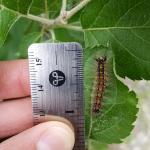 Gypsy Moth:(Lymantria dispar) host plants include but are certainly not limited to oak (favored), maple, birch, poplar, and many others. Gypsy moth caterpillars continue to feed and grow in size. Caterpillars observed on 6/7/18 in Amherst, MA are approximately 1 inch in length. Many are in the 3rd and 4th instars. (See Regional Reports above.) Caterpillars pictured in this week’s report have developed the red and blue pairs of warts or raised bumps recognizable in older gypsy moth caterpillars. They also have yellow coloration to their head capsule. Historically, gypsy moth caterpillars that have developed the yellow coloration on their head and those that are greater than ¾ inch in length are not as responsive to Btk (Bacillus thuringiensis Kurstaki) applications. (So the time for using that active ingredient has likely run out and professionals may need to start considering other options, such as spinosad.)
Gypsy Moth:(Lymantria dispar) host plants include but are certainly not limited to oak (favored), maple, birch, poplar, and many others. Gypsy moth caterpillars continue to feed and grow in size. Caterpillars observed on 6/7/18 in Amherst, MA are approximately 1 inch in length. Many are in the 3rd and 4th instars. (See Regional Reports above.) Caterpillars pictured in this week’s report have developed the red and blue pairs of warts or raised bumps recognizable in older gypsy moth caterpillars. They also have yellow coloration to their head capsule. Historically, gypsy moth caterpillars that have developed the yellow coloration on their head and those that are greater than ¾ inch in length are not as responsive to Btk (Bacillus thuringiensis Kurstaki) applications. (So the time for using that active ingredient has likely run out and professionals may need to start considering other options, such as spinosad.)
On 5/23/18 in Amherst, MA gypsy moth caterpillars were observed feeding on bur oak, elm, Norway maple, crabapple, fernleaf beech (Fagus sylvatica ‘Asplenifolia’), European linden, Rosa rugosa, and apple. Feeding damage from gypsy moth is becoming more apparent, and dark colored and hairy caterpillars can be seen on leaf undersides as well as leaf surfaces.
Despite the fungal outbreak that swept through the 2017 caterpillar population, some lucky caterpillars survived to pupation and emerged as adult moths. (However, adults were present in 2017 in far fewer numbers than would have existed without the fungus.) While it is very difficult to predict how much defoliation Massachusetts will see in 2018 due to gypsy moth caterpillar feeding, we can be certain that in areas where many egg masses were seen overwintering, pockets of defoliation could still occur in certain areas of the state this year. Thanks to the gypsy moth caterpillar-killing fungus, however, the population should be on the decline, but we cannot expect the caterpillars to disappear completely from Massachusetts landscapes this season.
- Winter Moth: (Operophtera brumata) caterpillars have pupated for the 2018 season. (See Regional Reports above.) Therefore, winter moth caterpillars will no longer be causing feeding damage in 2018 and they cannot be managed with chemical options at this time. Do not confuse the green color form of fall cankerworm (Alsophila pometaria) caterpillars for lingering winter moth caterpillars. Fall cankerworm caterpillars have three pairs of prolegs (one is shorter in length than the others are) while winter moth caterpillars have two pairs.
- Asian Longhorned Beetle: (Anoplophora glabripennis, ALB) Look for signs of an ALB infestation which include perfectly round exit holes (about the size of a dime), shallow oval or round scars in the bark where a female has chewed an egg site, or sawdust-like frass (excrement) on the ground nearby host trees or caught in between branches. Be advised that other, native insects may create perfectly round exit holes or sawdust-like frass, which can be confused with signs of ALB activity.
The regulated area for Asian longhorned beetle is 110 miles2 encompassing Worcester, Shrewsbury, Boylston, West Boylston, and parts of Holden and Auburn. If you believe you have seen damage caused by this insect, such as exit holes or egg sites, on susceptible host trees like maple, please call the Asian Longhorned Beetle Eradication Program office in Worcester, MA at 508-852-8090 or toll free at 1-866-702-9938. Adult insects of this species will not be present at this time of year.
To report an Asian longhorned beetle find online or compare it to common insect look-alikes, visit: http://massnrc.org/pests/albreport.aspx or https://www.aphis.usda.gov/pests-diseases/alb/report .
- Deer Tick/Blacklegged Tick: Ixodes scapularis adult females, following a blood meal, can lay a single egg mass (up to 1500 – 2000 eggs) in mid-late May, and then the female deer tick perishes. Larvae emerge from the eggs later in the summer. Larvae are tiny and six-legged. Prior to feeding, they are not known to be able to transmit disease. After feeding, the larvae drop from their host and molt, re-emerging the following spring as nymphs. Nymphs (from last year’s overwintering cohort) are active from May-August. Nymphs are eight-legged and about the size of the head of a pin. These tiny nymphs typically attach to small mammal hosts; however, they will readily feed on people and pets. Nymphs are capable of carrying Lyme disease, human Babesiosis, human Anaplasmosis, and deer tick virus. For images of all deer tick life stages, along with an outline of the diseases they carry, visit: http://www.tickencounter.org/tick_identification/deer_tick .
Anyone working in the yard and garden should be aware that there is the potential to encounter deer ticks. The deer tick or blacklegged tick can transmit Lyme disease, human babesiosis, human anaplasmosis, and other diseases. Preventative activities, such as daily tick checks, wearing appropriate clothing, and permethrin treatments for clothing (according to label instructions) can aid in reducing the risk that a tick will become attached to your body. If a tick cannot attach and feed, it will not transmit disease. For more information about personal protective measures, visit: http://www.tickencounter.org/prevention/protect_yourself .
Have you just removed an attached tick from yourself or a loved one with a pair of tweezers? If so, consider sending the tick to the UMass Laboratory of Medical Zoology to be tested for disease causing pathogens. To submit a tick to be tested, visit: https://www.tickreport.com/ and click on the red “Test A Tick” button. Results are typically available within 3 business days, or less. By the time you make an appointment with your physician following the tick attachment, you may have the results back from TickReport to bring to your physician to aid in a conversation about risk.
The UMass Laboratory of Medical Zoology does not give medical advice, nor are the results of their tests diagnostic of human disease. Transmission of a pathogen from the tick to you is dependent upon how long the tick had been feeding, and each pathogen has its own transmission time. TickReport is an excellent measure of exposure risk for the tick (or ticks) that you send in to be tested. Feel free to print out and share your TickReport with your healthcare provider.
You can also follow TickReport on Twitter @TickReport for timely updates from the Laboratory of Medical Zoology, including the latest tick and tick-borne disease related research.
- Eastern Tent Caterpillar: Malacosoma americanum tents are large and so are the eastern tent caterpillars. Tents may become vacant at this time as caterpillars wander away. Eastern tent caterpillars continue to be observed wandering on paved and dirt roads in Chesterfield, MA on 6/5/18, yet the number of wandering caterpillars has decreased in this location. Others are still reporting active caterpillars in other locations of the state (See Regional Reports above). Eastern tent caterpillars have likely begun to pupate in sheltered areas they locate, although not all individuals will do so at exactly the same time. Pupation for the species reportedly lasts around three weeks, and adult moths historically emerge between late June and early July.
- Elongate Hemlock Scale: Fiorinia externa is found on eastern, Carolina, and Japanese hemlock, as well as yew, spruce, and fir. Crawlers will be present this month and throughout the growing season and the overlap of many developmental stages at any given time can be observed. Treatments (active ingredients effective through contact) for the crawler, or mobile, stage of this insect may be made in late May through mid-June, or between 360-700 GDD’s, base 50°F. (Systemic options can be made at other times, such as the spring and fall.)
- Emerald Ash Borer: (Agrilus planipennis, EAB) This wood-boring beetle readily attacks ash (Fraxinus spp.) including white, green, and black ash and has also been found developing in white fringe tree (Chionanthus virginicus) and most recently, has been reported in cultivated olive (Olea europaea). Adult emerald ash borers will be emerging from their hosts (ash) in locations that have reached roughly between 450 – 550 GDD’s, base 50°F. At this time, this includes areas in the North Shore, East, Metro West, Pioneer Valley, and Berkshires (see Environmental Data above). This is important to note, as anyone using traps and lures to detect the presence of EAB in their community should have their traps hung at this time. Signs of an EAB infested tree may include D-shaped exit holes in the bark (from adult emergence in previous years), “blonding” or lighter coloration of the ash bark from woodpecker feeding (chipping away of the bark as they search for larvae beneath), and serpentine galleries visible through splits in the bark, from larval feeding beneath. Positive identification of an EAB-infested tree may not be possible with these signs individually on their own.
For further information about this insect, please visit: https://ag.umass.edu/fact-sheets/emerald-ash-borer . If you believe you have located EAB-infested ash trees, particularly in an area of Massachusetts not identified on the map provided, please report here: http://massnrc.org/pests/pestreports.htm .
- Euonymus Caterpillar: Yponomeuta cagnagella is of European origin and widespread in distribution throughout Europe. It was first reported in North America in Ontario in 1967. As of 5/23/18 and continuing through 5/30/18, euonymus caterpillars are present, feeding, and creating an ample amount of webbing at a location in Amherst, MA. The caterpillars are present by the thousands in an understory, forested area. At this location, they have eaten nearly all euonymus leaves in sight. Caterpillars were very active the morning of 5/23/18, feeding in large groups and dangling from host plant branches on webbing.
The euonymus caterpillars (larvae) feed in groups and envelop the foliage of the host plant in webs as they feed. Hosts include: Euonymus europaeus (tree form), E. kiautschovicus, E. alatus, and E. japonicus. Mature caterpillars are just under an inch in length, creamy yellow-gray in color with black spots and a black head capsule. By late June, these larvae pupate in white, oval-shaped cocoons which are typically oriented together vertically either on host plants or non-hosts in the area. Cocoons can be found in cracks and crevices, or webbed together leaves. The adult moth emerges in late June in most locations. The adult female secretes a gummy substance over her eggs which will harden, making them even more difficult to see. Eggs hatch by mid-August, at which time the tiny larvae prepare to overwinter beneath their eggshell-like covering. These larvae are inactive until the following year, when caterpillars group together to feed on newly emerging leaves, creating a mess of webs as they feed. There is one generation per year. Plants may be partially or entirely defoliated, and the plants at this location in Amherst are nearly defoliated. Management of young, actively feeding caterpillars with Bacillus thuringiensis is possible if deemed necessary, however many species of Euonymus are considered invasive themselves.
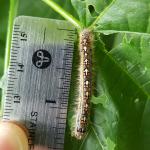
 Forest Tent Caterpillar: Malacosoma disstria caterpillars are still seen in Amherst, MA on 6/7/2018 some of them are 2 inches in length. One such caterpillar was seen resting in between the cracks and crevices of ash (Fraxinus spp.) bark. A slightly smaller caterpillar (1.5 inches) was seen feeding on European linden. Forest tent caterpillars are still significantly larger than gypsy moth caterpillars in this location at this time. They are hairy with visible blue lateral stripes and white “key-hole” or “penguin”-shaped spots from head to hind end dorsally. Susceptible hosts whose leaves are fed on by this insect include oak, birch, ash, maple, elm, poplar, and basswood.
Forest Tent Caterpillar: Malacosoma disstria caterpillars are still seen in Amherst, MA on 6/7/2018 some of them are 2 inches in length. One such caterpillar was seen resting in between the cracks and crevices of ash (Fraxinus spp.) bark. A slightly smaller caterpillar (1.5 inches) was seen feeding on European linden. Forest tent caterpillars are still significantly larger than gypsy moth caterpillars in this location at this time. They are hairy with visible blue lateral stripes and white “key-hole” or “penguin”-shaped spots from head to hind end dorsally. Susceptible hosts whose leaves are fed on by this insect include oak, birch, ash, maple, elm, poplar, and basswood.- Hemlock Looper: Two species of geometrid moths in the genus Lambdina are native insects capable of defoliating eastern hemlock, balsam fir, and white spruce. Adult moths lay their eggs on the trunk and limbs of hosts in September and October, and eggs will hatch by late May or early June. Monitor susceptible hosts for small, inch-worm like caterpillars at this time. Where populations are low, no management is necessary.
 Imported Willow Leaf Beetle: Plagiodera versicolora overwintered adults are present and continue to be active and found on willow foliage. Adult beetles will chew holes and notches in the leaves of willow. Egg laying was observed on 5/16/18, 5/23/18, and 5/30/2018 in Chesterfield, MA.Females lay yellow eggs in clusters on the undersides of leaves. As of 5/30/2018, eggs have hatched at the location in Chesterfield, MA and multitudes of small imported willow leaf beetle larvae are feeding in groups. By 6/7/2018, these larvae have grown larger in size and have skeletonized many leaves. Larvae are slug-like and bluish-green in color. They feed in clusters. Most plants can tolerate the feeding from this insect, and foliage will appear brown. Repeated yearly feeding can be an issue, in which case management of the young larvae may be necessary. Take care with treatment in areas near water.
Imported Willow Leaf Beetle: Plagiodera versicolora overwintered adults are present and continue to be active and found on willow foliage. Adult beetles will chew holes and notches in the leaves of willow. Egg laying was observed on 5/16/18, 5/23/18, and 5/30/2018 in Chesterfield, MA.Females lay yellow eggs in clusters on the undersides of leaves. As of 5/30/2018, eggs have hatched at the location in Chesterfield, MA and multitudes of small imported willow leaf beetle larvae are feeding in groups. By 6/7/2018, these larvae have grown larger in size and have skeletonized many leaves. Larvae are slug-like and bluish-green in color. They feed in clusters. Most plants can tolerate the feeding from this insect, and foliage will appear brown. Repeated yearly feeding can be an issue, in which case management of the young larvae may be necessary. Take care with treatment in areas near water. Lace Bugs: Stephanitis spp. lace bugs are active and damage is becoming more apparent. Yellow stippling on leaf surfaces, black colored tar-like spots on leaf undersides, and lace bug nymphs (immatures) were seen on leaf undersides on 5/30/18 and 6/7/18 in Amherst, MA on Rhododendron spp. foliage. Stephanitis spp. lacebugs such as S. pyriodes can cause severe injury to azalea foliage. S. rhododendri can be common on rhododendron and mountain laurel. S. takeyai has been found developing on Japanese andromeda, leucothoe, styrax, and willow. Stephanitis spp. lace bug activity should be monitored through September. Before populations become too large, treat with a summer rate horticultural oil spray as needed. Be sure to target the undersides of the foliage in order to get proper coverage of the insects. Fall or early spring soil treatment with imidacloprid has been effective, but be aware of the implications this may have on pollinators attracted to these flowering plants when making management decisions. Certain azalea and andromeda cultivars may be less preferred by lace bugs.
Lace Bugs: Stephanitis spp. lace bugs are active and damage is becoming more apparent. Yellow stippling on leaf surfaces, black colored tar-like spots on leaf undersides, and lace bug nymphs (immatures) were seen on leaf undersides on 5/30/18 and 6/7/18 in Amherst, MA on Rhododendron spp. foliage. Stephanitis spp. lacebugs such as S. pyriodes can cause severe injury to azalea foliage. S. rhododendri can be common on rhododendron and mountain laurel. S. takeyai has been found developing on Japanese andromeda, leucothoe, styrax, and willow. Stephanitis spp. lace bug activity should be monitored through September. Before populations become too large, treat with a summer rate horticultural oil spray as needed. Be sure to target the undersides of the foliage in order to get proper coverage of the insects. Fall or early spring soil treatment with imidacloprid has been effective, but be aware of the implications this may have on pollinators attracted to these flowering plants when making management decisions. Certain azalea and andromeda cultivars may be less preferred by lace bugs.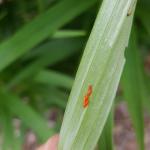
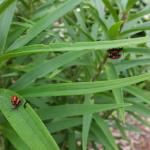
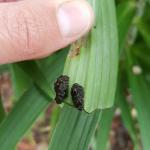 Lily Leaf Beetle: Lilioceris lilii overwintering adults continue to be active in Amherst, MA on 6/7/18 and mating is still occurring at this location. Susceptible hosts include Lilium spp. (Turk’s cap, tiger, Easter, Asiatic, and Oriental lilies) and Fritillaria spp. (Note: daylilies are not hosts.) Typically, in May, mating will occur and each female will begin to lay 250-450 eggs in neat rows on the underside of the foliage. In Amherst, MA, orange lily leaf beetle eggs were observed on the underside of host plant foliage on 5/16/2018 and some of these eggs hatched by 5/23/18. Frass-covered larvae were observed feeding on 5/23/18, 5/30/18, and again on 6/7/18 in Amherst, MA. Larvae are growing ever larger and eating entire leaves. Younger groups of eggs are hatching with still tiny larvae starting to feed by skeletonizing the leaf in groups. Where adults and larvae are seen, they can be removed from host plants with a gloved hand, where practical.
Lily Leaf Beetle: Lilioceris lilii overwintering adults continue to be active in Amherst, MA on 6/7/18 and mating is still occurring at this location. Susceptible hosts include Lilium spp. (Turk’s cap, tiger, Easter, Asiatic, and Oriental lilies) and Fritillaria spp. (Note: daylilies are not hosts.) Typically, in May, mating will occur and each female will begin to lay 250-450 eggs in neat rows on the underside of the foliage. In Amherst, MA, orange lily leaf beetle eggs were observed on the underside of host plant foliage on 5/16/2018 and some of these eggs hatched by 5/23/18. Frass-covered larvae were observed feeding on 5/23/18, 5/30/18, and again on 6/7/18 in Amherst, MA. Larvae are growing ever larger and eating entire leaves. Younger groups of eggs are hatching with still tiny larvae starting to feed by skeletonizing the leaf in groups. Where adults and larvae are seen, they can be removed from host plants with a gloved hand, where practical. - Roseslugs: Two species of sawfly can be found on the leaves of roses at this time. These small, caterpillar-like larvae will skeletonize the upper leaf surface and leave a “window-pane” like pattern behind. When present in large numbers, these insects are capable of defoliating their entire host. Management options include an insecticidal soap spray or a product containing spinosad.
- Spotted Lanternfly: (Lycorma delicatula, SLF) is not known to occur in Massachusetts. The Pennsylvania Department of Agriculture reported on 5/14/2018 that spotted lanternfly eggs had begun to hatch in Berks County, PA for the 2018 season. Small, black and white spotted nymphs (immatures) were seen in PA at that time.
This insect is a member of the Order Hemiptera (true bugs, cicadas, hoppers, aphids, and others) and the Family Fulgoridae, also known as planthoppers. This insect is a non-native species first detected in the United States in Berks County, Pennsylvania and confirmed on September 22, 2014. Until November 2017, this invasive insect was only known to Pennsylvania. It has now been reported from Delaware (November 20, 2017), New York (November 29, 2017), and most recently in Virginia (January 10, 2018). The Delaware Department of Agriculture announced the finding of a single female spotted lanternfly in New Castle County in the Wilmington, Delaware area. At this time, officials in Delaware note that it is unclear if this individual was an accidental hitchhiker, or evidence of an established population in the state. For more information about the find in Delaware, visit: https://news.delaware.gov/2017/11/20/spotted-lanternfly-confirmed-delaware/ . The New York State Department of Agriculture and Markets reported on November 29, 2017 the finding of a single dead individual spotted lanternfly in the state from earlier in the month. A single dead specimen was confirmed at a facility in Delaware County, New York, which is located south-west of Albany. The NYS Dept. of Agriculture and Markets states that this dead individual may have come in on an interstate shipment. For more information about the find in New York, visit: https://www.agriculture.ny.gov/AD/release.asp?ReleaseID=3637 . Most recently, Virginia Cooperative Extension announced the finding of a spotted lanternfly population in Frederick County, Virginia, on January 10, 2018. It was noted that at the location in Virginia, numerous adult lanternflies and egg masses were discovered, in addition to more at another site approximately 400 yards away. For more information about the find in Virginia, visit: https://ext.vt.edu/agriculture/commercial-horticulture/spotted-lanternfly.html .
The spotted lanternfly is considered native to China, India, and Vietnam. It has been introduced as a non-native insect to South Korea and Japan, prior to its detection in the United States. In South Korea, it is considered invasive and a pest of grapes and peaches. The spotted lanternfly has been reported from over 70 species of plants, including the following: tree of heaven (Ailanthus altissima) (preferred host), apple (Malus spp.), plum, cherry, peach, apricot (Prunus spp.), grape (Vitis spp.), pine (Pinus spp.), pignut hickory (Carya glabra), sassafras (Sassafras albidum), serviceberry (Amelanchier spp.), slippery elm (Ulmus rubra), tulip poplar (Liriodendron tulipifera), white ash (Fraxinus americana), willow (Salix spp.), American beech (Fagus grandifolia), American linden (Tilia americana), American sycamore (Platanus occidentalis), big-toothed aspen (Populus grandidentata), black birch (Betula lenta), black cherry (Prunus serotina), black gum (Nyssa sylvatica), black walnut (Juglans nigra), dogwood (Cornus spp.), Japanese snowbell (Styrax japonicus), maple (Acer spp.), oak (Quercus spp.), and paper birch (Betula papyrifera).
The adults and immatures of this species damage host plants by feeding on sap from stems, leaves, and the trunks of trees. In the springtime in Pennsylvania (late April - mid-May) nymphs (immatures) are found on smaller plants and vines and new growth of trees and shrubs. Third and fourth instar nymphs migrate to the tree of heaven and are observed feeding on trunks and branches. Trees may be found with sap weeping from the wounds caused by the insect’s feeding. The sugary secretions (excrement) created by this insect may coat the host plant, later leading to the growth of sooty mold. Insects such as wasps, hornets, bees, and ants may also be attracted to the sugary waste created by the lanternflies, or sap weeping from open wounds in the host plant. Host plants have been described as giving off a fermented odor when this insect is present.
Adults are present by the middle of July in Pennsylvania and begin laying eggs by late September and continue laying eggs through late November and even early December in that state. Adults may be found on the trunks of trees such as the tree of heaven or other host plants growing in close proximity to them. Egg masses of this insect are gray in color and look similar to gypsy moth egg masses.
Host plants, bricks, stone, lawn furniture, recreational vehicles, and other smooth surfaces can be inspected for egg masses. Egg masses laid on outdoor residential items such as those listed above may pose the greatest threat for spreading this insect via human aided movement.
For more information about the spotted lanternfly, visit this fact sheet: https://ag.umass.edu/landscape/fact-sheets/spotted-lanternfly .
- Spruce Spider Mite: Oligonychus ununguis is a cool-season mite that becomes active in the spring from tiny eggs that have overwintered on host plants. Hosts include spruce, arborvitae, juniper, hemlock, pine, Douglas-fir, and occasionally other conifers. This particular species becomes active in the spring and can feed, develop, and reproduce through roughly June. When hot, dry summer conditions begin, this spider mite will enter a summer-time dormant period (aestivation) until cooler temperatures return in the fall. This particular mite may prefer older needles to newer ones for food. Magnification is required to view spruce spider mite eggs. Tapping host plant branches over white paper may be a useful tool when scouting for spider mite presence. (View with a hand lens.) Spider mite damage may appear on host plant needles as yellow stippling and occasionally fine silk webbing is visible.
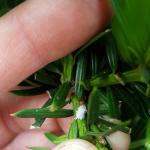 Taxus Mealybug: Dysmicoccus wistariae was spotted on taxus in Amherst on 5/23/18, 5/30/18, and again on 6/7/18. This insect will produce honeydew and lead to sooty mold growth, yellowing of needles, and sparsely foliated plants. Eventual dieback may be possible. This species is commonly associated with taxus in New England, but can be occasionally found on dogwood, rhododendron, Prunus spp., maple, andromeda, and crabapple. These mealybugs are found on stems and branches and particularly like to congregate at branch crotches. Management may be targeted between 246-618 GDD’s. Horticultural oil and neem oil may be used.
Taxus Mealybug: Dysmicoccus wistariae was spotted on taxus in Amherst on 5/23/18, 5/30/18, and again on 6/7/18. This insect will produce honeydew and lead to sooty mold growth, yellowing of needles, and sparsely foliated plants. Eventual dieback may be possible. This species is commonly associated with taxus in New England, but can be occasionally found on dogwood, rhododendron, Prunus spp., maple, andromeda, and crabapple. These mealybugs are found on stems and branches and particularly like to congregate at branch crotches. Management may be targeted between 246-618 GDD’s. Horticultural oil and neem oil may be used. Twolined Chestnut Borer: Agrilus bilineatus is a native jewel beetle (also known as a flatheaded borer) in the Family Buprestidae. This insect is also in the same genus as the invasive emerald ash borer. The twolined chestnut borer is native to Massachusetts, much of New England, and the eastern United States. This species has one generation per year and adults are typically active from April – August, depending upon location and temperature. Adults will conduct some maturation feeding on oak prior to mating. Females will lay clusters of tiny eggs in the cracks and crevices of bark. Larvae hatch from the eggs in 1-2 weeks and burrow through the bark into the cambium, where they feed in a similar manner to the emerald ash borer, creating meandering galleries as they feed. (The galleries of the twolined chestnut borer can be straight in very stressed trees.) Larvae typically mature by August – October and burrow to the outer bark where they create a chamber in which they overwinter. Pupation occurs the following spring and adults emerge through D-shaped exit holes that are approximately 1/5 inch wide. In the northern extent of this insect’s range, they can take 2 years to complete their life cycle. Larvae of this insect have been recorded from eastern white oak, common post oak, burr oak, scarlet oak, northern red oak, and eastern black oak. Adults have been recorded on fir and pin oak. In the case of this individual observed on 6/7/18 in Amherst, MA, it was lingering on an elm leaf. There are oaks nearby, so this could just be happenstance as the insect searches for a suitable host. These insects are attracted to stressed host plants and typically become a secondary factor in the decline of the tree.
Twolined Chestnut Borer: Agrilus bilineatus is a native jewel beetle (also known as a flatheaded borer) in the Family Buprestidae. This insect is also in the same genus as the invasive emerald ash borer. The twolined chestnut borer is native to Massachusetts, much of New England, and the eastern United States. This species has one generation per year and adults are typically active from April – August, depending upon location and temperature. Adults will conduct some maturation feeding on oak prior to mating. Females will lay clusters of tiny eggs in the cracks and crevices of bark. Larvae hatch from the eggs in 1-2 weeks and burrow through the bark into the cambium, where they feed in a similar manner to the emerald ash borer, creating meandering galleries as they feed. (The galleries of the twolined chestnut borer can be straight in very stressed trees.) Larvae typically mature by August – October and burrow to the outer bark where they create a chamber in which they overwinter. Pupation occurs the following spring and adults emerge through D-shaped exit holes that are approximately 1/5 inch wide. In the northern extent of this insect’s range, they can take 2 years to complete their life cycle. Larvae of this insect have been recorded from eastern white oak, common post oak, burr oak, scarlet oak, northern red oak, and eastern black oak. Adults have been recorded on fir and pin oak. In the case of this individual observed on 6/7/18 in Amherst, MA, it was lingering on an elm leaf. There are oaks nearby, so this could just be happenstance as the insect searches for a suitable host. These insects are attracted to stressed host plants and typically become a secondary factor in the decline of the tree.- Viburnum Leaf Beetle: Pyrrhalta viburni is a beetle in the family Chrysomelidae that is native to Europe, but was found in Massachusetts in 2004. Viburnum leaf beetle egg hatch was observed in Boston, MA on 5/4/2018. Viburnum leaf beetle larvae continue to feed and grow in size. (See Regional Reports above.) As the larvae grow larger, damage to plants becomes more significant. By early to mid-June, viburnum leaf beetle larvae will crawl down the host plant, enter the soil surface, and pupate. This typically occurs when the larvae are just under ½ inch in length. After pupation, by early July, adult beetles will emerge from the soil and begin feeding on viburnum foliage again prior to mating and laying eggs. This beetle feeds exclusively on many different species of viburnum, which includes, but is not limited to, susceptible plants such as V. dentatum, V. nudum, V. opulus, V. propinquum, and V. rafinesquianum. Larvae, where they are present, may be treated with a product containing spinosad. Some viburnum have been observed to have varying levels of resistance to this insect, including but not limited to V. bodnantense, V. carlesii, V. davidii, V. plicatum, V. rhytidophyllum, V. setigerum, and V. sieboldii. More information about viburnum leaf beetle may be found at http://www.hort.cornell.edu/vlb/
- White Spotted Pine Sawyer (WSPS): Monochamus scutellatus adults can emerge in late May throughout July, depending on local temperatures. The first report of a white spotted pine sawyer adult came from the Asian Longhorned Beetle Eradication Program in Worcester, MA. A concerned citizen in Hampshire County, MA reported (with a photo) a white spotted pine sawyer adult on 5/22/2018. This is a native insect in Massachusetts and is usually not a pest. Larvae develop in weakened or recently dead conifers, particularly eastern white pine (Pinus strobus). However, the adult white spotted pine sawyer looks very similar to the invasive Asian Longhorned Beetle, Anoplophora glabripennis, ALB. ALB adults do not emerge in Massachusetts until July and August. Beginning in July, look for the key difference between WSPS and ALB adults, which is a white spot in the top center of the wing covers (the scutellum) on the back of the beetle. White spotted pine sawyer will have this white spot, whereas Asian longhorned beetle will not. Both insects can have other white spots on the rest of their wing covers; however, the difference in the color of the scutellum is a key characteristic. See the Asian longhorned beetle entry above for more information about that non-native insect. (And where to go to report anything suspicious.)
- Woolly Apple Aphid: Eriosoma lanigerum may be found on apple, crabapple, hawthorn, mountain-ash, Pyracantha, and elm hosts. The primary (winter) host is elm, on which aphids infest emerging spring leaf growth, causing leaves to curl or close into stunted, rosette-like clusters found at twig tips. Woolly apple aphid was observed on elm on 5/23/2018 in Amherst, MA. On apple and crabapple, this species of aphid colonizes roots, trunks, and branches in the summer and is commonly found near previous wounds or callous tissue. On roots, the aphids cause swelled areas which can girdle and kill roots. The aphids, when found in above ground plant parts such as elm leaves are covered with white wax. Eggs are the overwintering stage on elm, which hatch in the spring in time for the nymphs to infest elm foliage. Following a few generations on elm, the aphids will develop into a winged form, which will disperse and seek out apple and crabapple. Small numbers of winged individuals were observed on elm on 5/31/2018 in Amherst, MA. These individuals were mixed with younger, non-winged aphids in their rosette-like deformed leaves. Multiple generations will occur on these alternate hosts in the summer and by the fall, a winged form will return to elm and mated females will lay eggs near elm buds.
- Woolly Elm Aphid: Eriosoma americanum females lay a single egg in the cracks and crevices of elm bark, where the egg overwinters. Eggs hatch on elm in the spring as leaves are unfolding. A young, wingless female hatched from the egg feeds on the underside of leaf tissue. This female aphid matures and gives birth to 200 young, all females, without mating. These aphids feed, and the elm leaf curls around them and protects them. Curled leaves, sheltering feeding, honeydew-producing aphids within, were observed on elm in Amherst, MA on 5/16/2018 and again on 5/23/2018. By the end of June, winged migrants mature and find serviceberry hosts. Oddly enough, on 5/31/2018 at the same location in Amherst, MA, a few winged individuals were seen within folded leaves. Most of the aphids were still wingless. Another set of females is produced. These new females crawl to and begin feeding on the roots of serviceberry. Multiple generations occur on the roots of serviceberry through the summer.
Concerned that you may have found an invasive insect or suspicious damage caused by one? Need to report a pest sighting? If so, please visit the Massachusetts Introduced Pests Outreach Project: http://massnrc.org/pests/pestreports.htm .
A note about Tick Awareness: deer ticks (Ixodes scapularis), the American dog tick (Dermacentor variabilis), and the lone star tick (Amblyomma americanum) are all found throughout Massachusetts. Each can carry their own complement of diseases. Anyone working in tick habitats (wood-line areas, forested areas, and landscaped areas with ground cover) should check themselves regularly for ticks while practicing preventative measures. Have a tick and need it tested? Visit the web page of the UMass Laboratory of Medical Zoology (https://www.tickreport.com/ ) and click on the red Test a Tick button for more information.
Reported by Tawny Simisky, Extension Entomologist, UMass Extension Landscape, Nursery, & Urban Forestry Program
Plant of the Week
A late blooming lilac and great small tree for the landscape. https://extension.umass.edu/plant-identification/japanese-tree-lilac
Report by Mandy Bayer, Extension Assistant Professor of Sustainable Landscape Horticulture, UMass Stockbridge School of Agriculture
Additional Resources
To receive immediate notification when the next Landscape Message update is posted, be sure to join our e-mail list and follow us on Facebook and Twitter.
For a complete listing of upcoming events, see our Upcoming Educational Events page.
For commercial growers of greenhouse crops and flowers - Check out UMass Extension's Greenhouse Update website
For professional turf managers - Check out Turf Management Updates
For home gardeners and garden retailers - Check out home lawn and garden resources. UMass Extension also has a Twitter feed that provides timely, daily gardening tips, sunrise and sunset times to home gardeners, see https://twitter.com/UMassGardenClip
Diagnostic Services
A UMass Laboratory Diagnoses Landscape and Turf Problems - The UMass Extension Plant Diagnostic Lab is available to serve commercial landscape contractors, turf managers, arborists, nurseries and other green industry professionals. It provides woody plant and turf disease analysis, woody plant and turf insect identification, turfgrass identification, weed identification, and offers a report of pest management strategies that are research based, economically sound and environmentally appropriate for the situation. Accurate diagnosis for a turf or landscape problem can often eliminate or reduce the need for pesticide use. For sampling procedures, detailed submission instructions and a list of fees, see Plant Diagnostics Laboratory
Soil and Plant Nutrient Testing - The University of Massachusetts Soil and Plant Nutrient Testing Laboratory is located on the campus of The University of Massachusetts at Amherst. Testing services are available to all. The function of the Soil and Plant Nutrient Testing Laboratory is to provide test results and recommendations that lead to the wise and economical use of soils and soil amendments. For complete information, visit the UMass Soil and Plant Nutrient Testing Laboratory web site. Alternatively, call the lab at (413) 545-2311.
Ticks are active at this time! Remember to take appropriate precautions when working and playing outdoors, and conduct daily tick checks. UMass tests ticks for the presence of Lyme disease and other disease pathogens. Learn more
